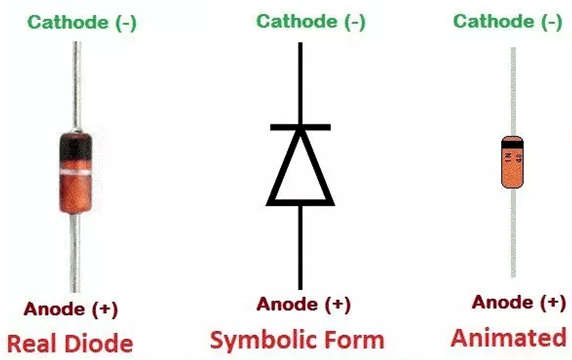- It functions essentially as a rapid switching diode. The functioning of switching diodes, which are typically single P-N diodes, is comparable to that of a typical switch. Switching diodes, such as the 1N4148, have significant resistance below a certain voltage. Above that particular voltage, however, they exhibit little resistance.
- Due to its reduced size, abundant availability, and low cost, it is the most often used diode. The maximum reverse recovery time and the power dissipation, which ranges from 80 mW to 1 kW, can be used to select a good switching diode. Switching diodes like the 1N4148, 1N4007, and others have a very broad range of uses, particularly in embedded systems.
- It is mostly utilized in switches that operate quickly. Its uses include high-speed rectification, quick switching, general-purpose switching, and protection for homes and other buildings, among others.

1N4148 Diode
- The silicon standard diode 1N4148 is utilized for lightning-fast switching operations. Its two operational modes are as follows.
- Progressive Bias
- Backward Biased
- In the Forward Biased operational mode, it functions as a closed switch and permits current to flow through it, whereas in the Reverse Biased operational mode, it serves as an open switch and prevents current flow. I’ve described it in the figure below.
![]()
- You can see in the image above that I created the simulation described above in Proteus.
- Our LED is ON because diode IN4148 is operating as a closed switch in the forward biased state and enabling current to flow through it.
- Our LED is off because diode IN4148 is operating as an open switch in the reverse biased state, which prevents current from passing through it.
- I’ve depicted the analogous circuit for both of these diode states in the diagram below.
![]()
1N4148 Diode Mechanical Design Parameters
- The table below shows the many parameters for this diode’s mechanical design.
![]()
- These are a few of the factors that went into the mechanical design of the 1N4148 Zener diode.
- In the table below, certain other mechanical properties are also listed.
![]()
- The parameters given in the table above can be verified from the figure shown below.
![]()
- We can observe that the diode has four major sides, A, B, C, and D, respectively, from the image above.
- According to the table above, every side has a different dimension.
- The discussion of the mechanical design criteria for this diode was thus briefly summarised.
Pin Configuration
- The 1N4148 diode’s pin layout is displayed below. This diode has two pins, and the descriptions of each pin are provided below.

- There is only one input terminal and one output terminal on the 1N4148.
- Anode and cathode are the names of the input and output terminals, respectively.
- A positive (?ve) charge indicates an anode, whereas a negative (?ve) charge indicates a cathode.
- Pin1 (Anode): This pin allows the flow of current.
- Pin2 (Cathode): The flow of current exists from this pin.
Applications of 1N4148 Diode
- Extremely fat switching purposes.
- High-speed rectification.
- General purpose switching.
- Protection circuits in telecommunication industries, offices, homes, etc.
- These were a few of the applications associated with this switching diode.
- 1N4148 diode is used in different electronics applications where AC to DC making is required.
- It protects different electronic components from damage by blocking voltage spikes.
- This type of diode is used in digital logic circuits.
- General & high-speed switching.
- Protection of components.
- Rectification.
- Signal filtering.
- It blocks incoming voltage wherever not necessary.
- It is also used in different circuits like power supply, voltage double & battery charger circuits.
